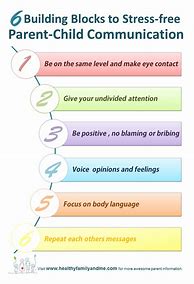Best Communication Techniques To Build a Positive Parent-Child Relationship
Raising a child is a beautiful but challenging journey. One of the most vital elements in building a strong and loving parent-child relationship is effective communication. It’s not just about talking; it’s about truly understanding and connecting with your child. By mastering certain techniques, you can foster an environment of open dialogue, mutual respect, and love.
Active Listening: The Foundation of Understanding
Active listening is the foundation of all effective communication, and it’s especially important when building a positive parent-child relationship. It means paying complete attention to what your child is saying, both verbally and nonverbally.
How to Practice Active Listening:
- Put down your phone and make eye contact. This shows your child that you’re genuinely interested in what they have to say.
- Don’t interrupt or jump to conclusions. Let your child finish their thoughts.
- Reflect back what you hear to make sure you understand. “So, you’re feeling frustrated because…”
- Ask open-ended questions to encourage your child to elaborate. “Tell me more about that.”
- Validate their feelings even if you don’t agree with their perspective. “It sounds like you’re really upset.”
Empathy and Validation: Seeing the World Through Their Eyes
Empathy is the ability to understand and share the feelings of another person. When you practice empathy, you try to see the world from your child’s perspective. You acknowledge their feelings, even if they’re different from your own.
How to Show Empathy:
- Try to understand their situation. What’s causing them stress? What are their struggles?
- Acknowledge their feelings. Don’t dismiss them as being silly or overblown.
- Use phrases like: “It sounds like you’re feeling…” or “I can understand why you’re upset.”
- Avoid judgmental language. “That’s a silly thing to be upset about.”
- Instead of giving advice, show support and understanding. “I’m here for you if you need anything.”
Clear and Concise Communication: Avoiding Misunderstandings
Clear and concise communication is essential for building trust and preventing misunderstandings. Make sure you’re using language that your child understands and that you’re being as clear and specific as possible.
How to Communicate Clearly:
- Use age-appropriate language. Avoid using jargon or overly complicated terms.
- Speak slowly and deliberately. This allows your child to process what you’re saying.
- Ask for clarification. “Are you sure you understand what I mean?”
- Avoid using sarcasm or humor that could be misinterpreted.
- Be open to feedback. “How can I explain this better?”
"I" Statements: Expressing Feelings Without Blaming
“I” statements are a powerful communication technique for expressing your feelings without blaming or attacking your child. They help to open up a dialogue and avoid defensiveness.
How to Use "I" Statements:
- Start with “I feel” and describe your emotion. “I feel frustrated when you don’t clean up your toys.”
- Explain the behavior that triggered your feelings. “When I see your toys all over the floor, I feel frustrated.”
- Avoid using “you” statements. “You make me so mad when you don’t listen to me.”
- Be specific and factual. “I feel frustrated when you don’t put your dishes away.”
- Focus on your own feelings and avoid trying to change your child’s behavior.
Positive Reinforcement: Encouraging Desired Behavior
Positive reinforcement is a powerful tool for motivating children and encouraging positive behaviors. It involves rewarding your child for doing the right thing.
How to Use Positive Reinforcement:
- Catch your child doing something right. “Thank you for putting your toys away.”
- Use verbal praise. “That was very kind of you to help your sister.”
- Provide tangible rewards. “If you finish your homework, you can have a special treat.”
- Be specific about the behavior you’re rewarding. “I appreciate you cleaning your room without being asked.”
- Avoid using punishment or threats. “If you don’t clean your room, you’re going to be grounded.”
Setting Boundaries: Creating a Safe and Structured Environment
Setting clear and consistent boundaries helps children feel secure and know what’s expected of them. They provide structure and support, and they help children learn self-discipline.
How to Set Effective Boundaries:
- Be clear and consistent. Don’t waver or make exceptions.
- Explain the reasons behind your boundaries. “It’s important to be respectful of other people’s time.”
- Be firm and assertive. “No, you can’t stay up past bedtime.”
- Avoid being overly controlling. Give your child some autonomy and freedom to make choices.
- Be prepared to enforce your boundaries. Follow through with consequences when necessary.
Conflict Resolution: Navigating Disagreements with Respect
Conflicts are a natural part of any relationship, but it’s important to learn how to resolve them in a healthy and respectful way.
How to Resolve Conflicts:
- Take a break. If you’re feeling angry or frustrated, take a few minutes to calm down before talking to your child.
- Listen to your child’s perspective. Try to understand their point of view.
- Use “I” statements to express your feelings without blaming your child.
- Work together to find a solution. “What can we do to make things better?”
- Don’t force a solution. Sometimes, the best solution is to agree to disagree.
Family Meetings: Creating a Space for Open Dialogue
Family meetings are a great way to encourage open communication and involve everyone in making decisions. They can be a fun way to discuss issues, make plans, and strengthen family bonds.
How to Hold Effective Family Meetings:
- Set aside a regular time for family meetings.
- Create a comfortable atmosphere. Make sure everyone feels safe to share their thoughts and feelings.
- Establish ground rules. “Everyone gets to speak without interruption.”
- Discuss a variety of topics such as chores, family events, or personal concerns.
- Make decisions together. “How do you think we should solve this problem?”
Time and Attention: Prioritizing Quality Interactions
Spending quality time with your child is essential for building a strong relationship. It’s not just about the amount of time you spend together, but about the quality of the interaction.
How to Prioritize Quality Time:
- Make eye contact and put away distractions when you’re talking to your child.
- Engage in activities that you both enjoy. Go for walks, play games, read books together.
- Listen actively and be truly present.
- Make time for one-on-one conversations. Even a few minutes each day can make a difference.
- Show affection and love. Hugs, kisses, and words of encouragement go a long way.
The Power of Humor: Lightening the Mood and Building Bonds
Laughter is a powerful tool for building connections and easing tension. Sharing a laugh with your child can create a more positive and enjoyable atmosphere.
How to Use Humor:
- Tell jokes and share funny stories.
- Play games that involve laughter and silliness.
- Don’t be afraid to laugh at yourself. This shows your child that you’re human.
- Find humor in everyday situations. A silly moment can brighten up even the most challenging day.
Conclusion
Effective communication is the cornerstone of a positive parent-child relationship. By implementing these techniques, parents can create an environment of open dialogue, understanding, and mutual respect. This fosters a strong bond, promotes emotional well-being, and prepares children to navigate the complexities of life with confidence and resilience. Remember, the journey to a positive parent-child relationship is an ongoing process that requires patience, empathy, and a commitment to building strong communication skills.
FAQ
Q: How can I encourage my teenage child to communicate more openly with me?
A: Try creating opportunities for casual conversations. Avoid jumping in with advice or lectures. Be patient and show that you’re a safe and supportive person to talk to.
Q: What are some ways to deal with a child who is constantly arguing?
A: Establish clear expectations and boundaries for arguments. When an argument starts, try to remain calm. Encourage your child to use “I” statements to express their feelings.
Q: How can I make sure I’m not overreacting to my child’s behavior?
A: Take a few deep breaths before reacting. Try to see the situation from your child’s perspective. Remember that kids are still learning how to handle their emotions.
Q: What if my child is really struggling to communicate their feelings?
A: It may be helpful to consult with a therapist or counselor who can help your child learn healthy communication skills.
Remember, communication is a two-way street. As parents, we can do our best to model positive communication skills for our children. The more we practice effective communication, the stronger and more loving our relationships will become.

